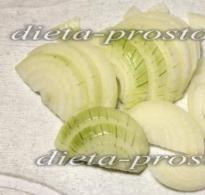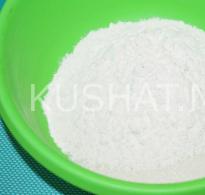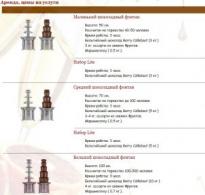How many calories in lightly salted hamsa. Fish Azov and Black Sea anchovy - "Fish, which is compared in taste with black caviar
Hamsa refers to one of the varieties of anchovies. This coastal schooling fish lives mainly in the eastern Atlantic Ocean. In addition, it is found in the waters of the Black and Mediterranean Seas, and in the summer months it often enters the Baltic, Azov and even the North Seas.
Appearance
The body length of the anchovy does not exceed 15 - 20 cm. The color of its back can vary from black-gray to blue-green. The sides of her beautiful white-silver color. Often along the side of the anchovy you can see a narrow longitudinal strip, cast with a metallic sheen.
A bit of history
Hamsa has been known to mankind since ancient times. Crimean fishermen at the beginning of our era sold this fish to the ancient Greeks and Romans. The ancient Greek geographer and historian Strabo wrote that the hamsa was highly valued in those ancient times and was second only to bread in its importance. During archaeological excavations on the Crimean coast, the remains of nets were found, with the help of which fishermen caught anchovy, as well as large wooden vats intended for salting it.
The ancient Greeks and Romans valued anchovy meat for its special tenderness and peculiar, slightly bitter taste. In ancient times, salted anchovy was mainly used as food. Also, a rather sour and spicy sauce called gurum was prepared from this fish.
And today anchovy is still in great demand among consumers, which is explained not only by its excellent taste, but also by its wide availability. This fish is still one of the important fishery objects. Mostly salted anchovy is on sale, but sometimes fresh-frozen is also found. They make stew and pastes from it, add it to various salads. In Italian cuisine, fragrant and tasty pasta is prepared from anchovy, and olives are also stuffed with it.
The benefits of anchovy
Hamsa is considered one of the best fish delicacies. It can be eaten whole, without removing small bones from the fillet. Since it is the skin and bones of the fish that contain the most calcium and phosphorus, the anchovy can be safely called an important source of these elements. In addition, this fish contains molybdenum, nickel, fluorine, chromium and zinc. It is a useful food product for people of all ages. In terms of its nutritional value, it is practically in no way inferior to beef, but the protein contained in it is better absorbed by the human body. At the same time, the calorie content of anchovies is quite low and, without fear of gaining extra pounds, can be included in their diet by those who follow a diet.
Anchovy is also a source of polyunsaturated fatty acids that help lower serum cholesterol levels, reduce the risk of blood clots, and improve lipid profile. In addition, polyunsaturated fatty acids prevent the development of malignant neoplasms, diseases of the cardiovascular system and kidneys, and in the event of these diseases, they can significantly slow down their progression.
It has been proven that anchovy has a beneficial effect on male potency. In this regard, nutritionists advise the stronger sex to regularly include this fish in their menu.
Anchovy calorie content and its composition
Anchovy contains 2% fat, 17.5% protein and 0% carbohydrates. In addition, it contains vitamin PP, as well as macro- and microelements (chlorine, sulfur, zinc, chromium, fluorine, molybdenum, nickel, calcium, phosphorus, etc.).
The calorie content of anchovies is quite low and amounts to only 88 kcal per 100.0 g of the product.

Salted anchovy
In appearance and taste, salted anchovy is very similar to sprat. It differs from it in more tender and pinkish meat. Salted anchovy is a favorite dish of many people. It is especially tasty with boiled or oven-baked potatoes.
However, salted anchovy contains too much salt. Therefore, you should not get too carried away with it, so as not to put a lot of stress on the urinary system. People suffering from diseases of the kidneys and / or the cardiovascular system should completely exclude salted anchovies from their diet.
Video from YouTube on the topic of the article:
Hamsa belongs to one of the varieties of anchovies. Another name for this fish is European anchovy. Its small size varies from fourteen to twenty centimeters. The sides of this fish are painted silvery white, and the back is black-gray or bluish-green. A distinctive feature of anchovy is a barely noticeable longitudinal strip with a metallic sheen, located along the sides. The taste of this fish is unusual. It is tender, but with a specific bitterness. Exquisite taste, affordable price makes this fish popular. It is used to prepare various dishes. And what are the beneficial properties of Hamsa?
Useful properties of hamsa:
This fish contains minerals: nickel, zinc, molybdenum, chromium, fluorine; vitamin RR. It is also rich in omega-3 semi-saturated fatty acids. The advantage of hamsa is its low calorie content. The use of this fish leads to a decrease in cholesterol in the blood. Hamsa is eaten with bones, which favorably affects the condition of bone tissue. It prevents the appearance of diseases, heart, cardiovascular system. Fish reduces the risk of blood clots. It can be used in the fight against cancer. The nutritional value of this product is high, as it contains a large amount of natural protein, which is easily absorbed by the body. Regularly eating anchovy, men can affect their potency. It acts as an aphrodisiac. Also, fish has a positive effect on the body of people who suffer from kidney disease. This product slows down the development of diseases and relieves their symptoms. Hamsa can also be used as a remedy that restores heart rhythm, reduces pressure in hypertension. It prevents the occurrence of a large number of attacks in people with angina pectoris. Fish is also useful in that it acts as a source of iodine, as it is a marine fish.
Contraindications to the use of anchovy:
This fish, as a rule, does not cause severe harm to the body. However, do not get carried away with anchovy in salty form. Its excessive use leads to the occurrence of diseases of the urinary system. In addition, the high salt content in this product can put a strain on the internal organs. You should refrain from eating such fish and people with individual intolerance.
Hamsa or kamsa, or gavros - a small fish, outwardly similar to sprat, lives in the Atlantic Ocean from the Canary Islands to the Bay of Biscay, the Black, Azov and Mediterranean Seas, is found in the Baltic and North Seas, the Indian Ocean in the region of Somalia.
It is characterized by an elongated body 10-17 cm long and a weight of 15-30 g, a color from silver-black to blue-green, a large mouth, and well-developed fins. Anchovy meat is pink, with a more delicate taste than sprat.
Hamsa differs according to habitats:
- Hamsa Atlantic reaches a weight of up to 50 g and a size of up to 20 cm.
- Hamsa Mediterranean in length reaches 12-15 cm.
- Hamsa is the most numerous fish of the Black Sea, grows up to 10-11 cm in length.
- Hamsa Azov is distinguished by a lighter color and small size - 8-10 cm in length.
Compound
Hamsa is a valuable fish product containing:
- complete proteins and essential amino acids;
Interesting! 200 g of anchovy are able to satisfy the daily need of the human body for essential amino acids: tryptophan, lysine, taurine, methionine.
- omega-3 fatty acids;
Interesting! Hamsa refers to fatty varieties of fish.
- extractives;
- ash;
- 55% water;
Curious! The fatter the fish, the less water it contains. Lean fish species contain up to 80% water.
- vitamins: PP, A, D, E, F;
Important! Vitamin F is responsible for the health of the skin, prevents the development of atherosclerosis, thrombosis, hypertension.
- trace elements: calcium, phosphorus, iodine, chlorine, sulfur, zinc, sodium, magnesium, chromium, fluorine, molybdenum, nickel, iron.
Beneficial features
- The use of anchovy is recommended for people of all ages, since its beneficial substances have a strengthening effect on bones and teeth, and prevents the development of atherosclerosis.
- Anchovy dishes can increase male potency, prevent the formation of blood clots, angina attacks and the development of malignant tumors.
- In case of kidney disease and malfunction of the thyroid gland, it is also recommended to eat anchovy dishes.
- Due to the low calorie content in hamsa, it is recommended for steamed, baked in the oven or boiled for weight loss diet.
- The nutritional properties of anchovy are not inferior to beef, and its proteins are better absorbed.
Interesting! The only contraindication to the use of anchovy is individual intolerance to fish products.
What to cook
Hamsa, despite its small size and universal availability, is a fish delicacy.
It is used whole, along with the bones, for cooking:
- baked anchovy with vegetables and potatoes;
- stewed anchovies with tomatoes and onions;
- meatballs or cutlets from anchovy;
- fried anchovy;
- body - an old Russian dish, such as fish zrazy;
- hamsa in batter or deep-fried;
- pickled anchovy;
- stuffed anchovy;
- vinaigrette and various salads with anchovy;
- borscht and fish soups;
- casseroles and fish fondue;
- fish pate, pasta or stew;
- shells, fish pilaf and sauces.
It is also steamed, salted, dried or dried. Dried anchovy is also ground into a fine powder and used as a seasoning for fish dishes.
Anchovy recipes are available in Turkish, Bulgarian, Greek, Sicilian, French, Portuguese and Spanish cuisines.
The Greeks cook it wrapped in grape leaves, the Sicilians make pizza with hamsa, and the French - hamsa a la indorate, the Bulgarians fry and eat it as a beer snack.
Worth a try! Usually lightly salted anchovy is combined with strongly chilled vodka, and lovers of refined gastronomic tastes should try it with a cup of black coffee.
- In ancient times, anchovy was used to make garum sauce, the recipe of which has survived to this day. The recipe for one of the oldest sauces includes anchovy, salt, wine and vinegar.
- The Greek colonies located in the Crimea received a huge income from the anchovy trade, this is evidenced by the records of the historian Strabo and the poet Archestratus, as well as the coins of the ancient Panticapaeum with the image of a fish.
- The number of anchovy in the Black Sea is evidenced by the fact recorded in 1859, when the Balaklava Bay was flooded with such a quantity of this fish that no water was visible. The stench spreading from the accumulated, dying in cramped and rotting fish was so strong that the silver and paintings in the surrounding houses turned black. This unbearable smell was weathered then for a whole year. After 8 years, the fish disaster happened again, albeit on a smaller scale.
- 1/10 of the annual catch of fish by Greek fishermen in our time is precisely anchovy.
- The Laz people, who are a Georgian sub-ethnic group living in Turkey and Georgia, make jam from dried anchovy, boiling it in lemon-sugar syrup.
Hamsa is a type of fish that lives in flocks, lives in the seas and oceans, is usually called sprat in the common people. Hamsa at all times was a very popular commodity, it is inferior, perhaps, only to bread. In ancient times, the Romans and Greeks bought this fish from ordinary fishermen. This is evidenced by many archaeological finds.
Hamsa: general information
The fish is quite small in length, the average size is 20 centimeters, but smaller ones are also found. It is blackish gray in color.
This fish is quite peaceful and harmless, it feeds on plankton and small algae, however, it is very tenacious. Easily tolerates temperature changes, feels normal in sea water with high salinity.
There are many varieties of this fish, but only 3 of its species are used for food. It is highly valued in the world market, not so much for its taste, but for its affordable price. On the shelves of stores, it is most often presented in a salted form, if you want to buy fresh and cook it yourself, then go to the market.
The main way of cooking fish is salting, however, this does not mean at all that it is the only one. The fish is good both boiled and fried. You can make minced fish from it, which is perfect for making fish cakes. Fish can be considered a dietary delicacy, since 100 grams of the product contains only 90 kcal.
Useful properties of hamsa
- Fish contains a large amount of vitamins and minerals, so it is suitable for people of almost any age, and even for those who follow a special diet.
- This product is very nutritious and is not inferior to even the most useful varieties of meat. It is believed that it is even more advisable to eat fish, since the protein contained in it is better absorbed by the human body.
A lot of useful properties
- Hamsa can be consumed by those who are on a diet for weight loss. The fish itself is low in calories, so if steamed or boiled, it can be eaten in a fairly decent amount.
- Since anchovy is a marine fish, it contains fatty acids. These same acids help get rid of blood clots, remove cholesterol from the body, significantly reduce the risk of cancer, spare the heart and kidneys. If a person is already ill with a particular disease, then regular use of anchovy will help him maintain his health in relative order for longer.
- When a man regularly eats anchovy, after a while it will be possible to notice that his potency has improved significantly.
- There are bones in the fish, but they are quite small, so anchovy can be eaten along with the bones. This will help a person to maintain his own bone skeleton in a normal way, and in addition, you can feed a child with anchovy without fear that he will choke on large bones.
- It is useful to use this type of fish for those who have problems with the thyroid gland.
- It is also useful for women who want to be beautiful. If a lady notices that her hair has grown dull, her nails began to break, and her skin began to peel off, then you should add at least a small amount of this fish to your daily diet, and very soon the skin, hair and nails will return to normal.
- Such fish should also be included in the children's menu, as it contributes to harmonious growth and development.
The use of anchovy
As mentioned above, anchovy can be found on sale in a salted form, this is the main way to use it. It tastes like sprat, but the anchovy is fatter, its meat is pinker and more tender.
Hamsa sandwich
However, you should not limit yourself to just salting at all. Fish can be boiled or fried, and in this form it goes well with potatoes. This fish, if you purchased it fresh, can be cooked in any way: cook soup from it, bake with vegetables or stew, scroll it into minced meat and sculpt fish cakes.
And abroad you can see more sophisticated ways of cooking fish. Sauce, pate, stew are made from it, added to various salads. If desired and special skill, such fish can even be stuffed.
Hamsa harm to the human body
As such, there is no harm from this fish, however, it should not be eaten by those who are allergic to fish products.
Problems can arise if a person is a lover of salted fish and enjoys anchovy in this form too often:
Osteochondrosis
- Very often, unscrupulous sellers put spoiled or simply low-quality fish into salting, so there is a chance to get poisoned by it. However, avoiding this is very simple, you just need to buy fresh fish and salt at home yourself.
- If you eat fish in a salty form, then salt will accumulate in the bones, and this will lead to osteochondrosis. In order to avoid this, anchovy should be eaten in a lightly salted form, then such a disease can not be afraid at all.
- Frequent use of salted fish can damage the excretory system, so those who have problems with the kidneys and bladder should opt for boiled, fried, baked fish, but not salty at all.
Hamsa Recipes
- Hamsa lightly salted. Take 1 kilogram of pre-processed fish, 100 grams of salt, spices to taste. Combine salt and spices in a saucepan with water, put on fire and let the solution boil. After that, wait a while until it cools down completely. Transfer the fish to a deep bowl in which it will be salted, cover with a lid and refrigerate. After 8-10 hours it will already be ready to eat.
- Hamsa sandwiches. This is a wonderful and quick snack for lovers of this fish. Spread butter on brown bread with a thin layer, put a fish cut lengthwise on top, decorate with dill sprigs or any other herbs.
- Hamsa fried. Clean the fish and remove the heads if desired, in principle, you can fry with them. Salt and pepper the fish, roll each in flour and transfer to a preheated pan with vegetable oil. Fry until golden brown. When the fish is ready, transfer it to a napkin and remove excess fat in this way. You can serve it with potatoes and vegetables.
Thus, hamsa is a very valuable product that absolutely anyone will like and afford. You can cook fish the way you like it, and if you haven’t tried it yet, then be sure to do it.
Feb 28, 2017Violetta Lekar
Anchovy, which can be safely attributed to the traditional components of cooking in the post-Soviet space, is called a small fish that looks like a sprat.
A more detailed description of the fish speaks of sizes from 8 to 20 centimeters in length, an elongated body, protruding upper jaw, and small teeth. Most of its varieties have a green back, a silvery-white belly, bright gray sides, and yellowish gill covers.
The variety of this fish, whose predominant habitat is the Sea of \u200b\u200bAzov, is distinguished by the most modest size and a lighter color of the back, for which it received the additional name of the gray back.
Wikipedia also defines it as European anchovy. Other alternative names for fish: kamsa, gavros.
Popularity is largely facilitated by its low price. No less relevant is the benefit that it can bring to a person.
Where does she live?
The main habitat of this fish is Atlantic Ocean, Mediterranean, Black and Azov seas. It is also found in the North and Baltic Seas, where it enters during the warm season, and in the Indian Ocean off the coast of Somalia.
Such a wide distribution is explained by the fact that the fish feels quite comfortable in a wide range of indicators of salinity and water temperature.
Main types
The anchovy varieties distinguished in ichthyology are differentiated according to the habitats of a particular species. It is customary to single out among them the following:
- Atlantic
- mediterranean
- Black Sea
- Azov.
Hamsa, found in the waters of the Atlantic, has the largest dimensions and can reach 20 cm in length and 50 grams of weight. In the Mediterranean, the dimensions are already more modest - up to 15 cm. They are even more modest in the Black Sea - no more than 12 cm. And the smallest Azov does not exceed 8–10 cm in length.
In the Black Sea, this fish is the most common.
As for the Sea of Azov, it enters the Sea of Azov only in summer, and for the winter nests in the Black Sea, mainly in the Novorossiysk region.
Features of biology
Anchovy shows activity in the summer, when it stays in warm layers of water close to the surface, mainly in the coastal zone. And closer to winter it goes south and into the depths. The maximum depth of its wintering is estimated at 400 meters. Usually in the Mediterranean it is found in winter at a depth of up to 150 meters, in the Black - up to 140, but most often it is limited to 40-70 meters.
The temperature that is comfortable for her is from +5 to +28 Celsius.
It spawns from April to November, the peak period is in the summer, which is explained by the optimal temperature for this process - + 18- + 26 degrees.
Anchovy individuals live on average up to four years, and can often spawn in the first year of life. However, many individuals at the age of 0–2 years do not survive wintering.
Despite the high mortality of young fish during wintering, precedents are known when its high fecundity caused an ecological imbalance and created problems not only for herself, but also for people.
The first such precedent was known in 1859 in Balaklava. A real pandemonium of anchovies happened in the local bay. The fish died in the crush and from lack of oxygen. And the smell from their decomposing bodies was so strong, then it disappeared throughout the year, and silverware and paintings blackened from it in city houses.
Then a similar emergency, however, not so global in scale, was repeated in the city in 1867.
The main food of the anchovy serves zooplankton, but with its deficiency, it does not disdain phytoplankton. Its main competitors in the food chain are other small fish, and in the Sea of \u200b\u200bAzov and fry of larger species.
Anchovy itself is eaten by pike perch, herring, various bonito, less often - seagull, petrel, beluga and dolphin. Her caviar becomes the prey of jellyfish, sagits and Azov sprat.
Nutritional value of anchovies
Anchovy is usually caught during the wintering period - October to May. For this purpose, purse seines are used, less often set ones are used. The most valuable, in terms of fat content, is fish caught in the fall. So, in the Azov anchovy at this time, this figure can reach 28%.
By the way, anchovy accounts for 10% of the average annual catch of fishermen in Greece.
Anchovy does not contain carbohydrates.
This fish is rightfully considered a delicacy. In particular, the taste of its meat is somewhat more tender than that of sprat.
It is customary to highlight such useful properties of the product:
- In hamsa, calorie content is estimated at 88 kilocalories per 100 grams of product.
- 200 grams is enough to cover the daily requirement of the human body for amino acids such as taurine, lysine, methionine and tryptophan.
- It also contains iodine, zinc, iron, nickel, magnesium, fluorine, chromium, sulfur, calcium, phosphorus and molybdenum, omega-3 fatty acids, a number of useful vitamins.
- Hamsa is recommended to be eaten for the prevention of cardiovascular diseases (thrombosis, atherosclerosis, hypertension - this is facilitated by the content of vitamin F in the product), cancer, treatment and prevention of skin diseases, kidney and thyroid diseases.
- Steamed fish, boiled or baked in the oven, is recommended for those who want to lose weight.
- In terms of energy value and nutritional properties, the protein contained in fish does not lag behind beef, while being better absorbed by the body.
It is worth adding that the price against the background of meat is not so high.
It can bring harm only in case of individual intolerance to it.
How to cook hamsa
First of all, a modern Russian associates anchovy with salted fish sold in retail chains. However, this is far from the only one culinary hypostasis.
Hamsa is fried, including deep-fried or battered, boiled in water and steamed, dried, dried, baked with potatoes and vegetables, stewed with onions and tomatoes, marinated, cutlets and meatballs, fondue and casseroles are made from it, used as an ingredient for various salads, including vinaigrette, soups and borscht, fish pastes, stews, various pastas, pilaf, sauces.
In Sicily, they make pizza with hamsa. And in Bulgaria, fried anchovy is popular as an inexpensive beer snack.
In ancient Greece, anchovy was prepared salted garum sauce. In addition to the fish and salt itself, vinegar and wine were used, but, unfortunately, the recipe has not survived to this day.
Anchovy dishes are known in Greek, Bulgarian, Portuguese, French and Spanish cuisines.
Well, it’s time to call the most exotic jam from it, which is made by the Laz - the Georgian sub-ethnos, compactly living along the Black Sea coast of Georgia and Turkey. To do this, they put the fish in a lemon-sugar sauce and boil it.
Hamsa refers to one of the varieties of anchovies. This coastal schooling fish lives mainly in the eastern Atlantic Ocean. In addition, it is found in the waters of the Black and Mediterranean Seas, and in the summer months it often enters the Baltic, Azov and even the North Seas.
Appearance
The body length of the anchovy does not exceed 15 - 20 cm. The color of its back can vary from black-gray to blue-green. The sides of her beautiful white-silver color. Often along the side of the anchovy you can see a narrow longitudinal strip, cast with a metallic sheen.
A bit of history
Hamsa has been known to mankind since ancient times. Crimean fishermen at the beginning of our era sold this fish to the ancient Greeks and Romans. The ancient Greek geographer and historian Strabo wrote that the hamsa was highly valued in those ancient times and was second only to bread in its importance. During archaeological excavations on the Crimean coast, the remains of nets were found, with the help of which fishermen caught anchovy, as well as large wooden vats intended for salting it.
The ancient Greeks and Romans valued anchovy meat for its special tenderness and peculiar, slightly bitter taste. In ancient times, salted anchovy was mainly used as food. Also, a rather sour and spicy sauce called gurum was prepared from this fish.
And today anchovy is still in great demand among consumers, which is explained not only by its excellent taste, but also by its wide availability. This fish is still one of the important fishery objects. Mostly salted anchovy is on sale, but sometimes fresh-frozen is also found. They make stew and pastes from it, add it to various salads. In Italian cuisine, fragrant and tasty pasta is prepared from anchovy, and olives are also stuffed with it.
The benefits of anchovy
Hamsa is considered one of the best fish delicacies. It can be eaten whole, without removing small bones from the fillet. Since it is the skin and bones of the fish that contain the most calcium and phosphorus, the anchovy can be safely called an important source of these elements. In addition, this fish contains molybdenum, nickel, fluorine, chromium and zinc. It is a useful food product for people of all ages. In terms of its nutritional value, it is practically in no way inferior to beef, but the protein contained in it is better absorbed by the human body. At the same time, the calorie content of anchovies is quite low and, without fear of gaining extra pounds, can be included in their diet by those who follow a diet.
Anchovy is also a source of polyunsaturated fatty acids that help lower serum cholesterol levels, reduce the risk of blood clots, and improve lipid profile. In addition, polyunsaturated fatty acids prevent the development of malignant neoplasms, diseases of the cardiovascular system and kidneys, and in the event of these diseases, they can significantly slow down their progression.
It has been proven that anchovy has a beneficial effect on male potency. In this regard, nutritionists advise the stronger sex to regularly include this fish in their menu.
Anchovy calorie content and its composition
Anchovy contains 2% fat, 17.5% protein and 0% carbohydrates. In addition, it contains vitamin PP, as well as macro- and microelements (chlorine, sulfur, zinc, chromium, fluorine, molybdenum, nickel, calcium, phosphorus, etc.).
The calorie content of anchovies is quite low and amounts to only 88 kcal per 100.0 g of the product.

Salted anchovy
In appearance and taste, salted anchovy is very similar to sprat. It differs from it in more tender and pinkish meat. Salted anchovy is a favorite dish of many people. It is especially tasty with boiled or oven-baked potatoes.
However, salted anchovy contains too much salt. Therefore, you should not get too carried away with it, so as not to put a lot of stress on the urinary system. People suffering from diseases of the kidneys and / or the cardiovascular system should completely exclude salted anchovies from their diet.
Video from YouTube on the topic of the article:
Found a mistake in the text? Select it and press Ctrl + Enter.
Do you know that:
A job that a person does not like is much more harmful to his psyche than no job at all.
An educated person is less prone to brain diseases. Intellectual activity contributes to the formation of additional tissue that compensates for the diseased.
Millions of bacteria are born, live and die in our intestines. They can only be seen at high magnification, but if they were brought together, they would fit in an ordinary coffee cup.
A person taking antidepressants will, in most cases, become depressed again. If a person coped with depression on his own, he has every chance to forget about this state forever.
When lovers kiss, each of them loses 6.4 calories per minute, but in the process they exchange almost 300 different types of bacteria.
In addition to people, only one living creature on planet Earth suffers from prostatitis - dogs. These are really our most faithful friends.
The rarest disease is Kuru disease. Only representatives of the Fur tribe in New Guinea are ill with it. The patient is dying of laughter. It is believed that the cause of the disease is the eating of the human brain.
According to statistics, on Mondays the risk of back injuries increases by 25%, and the risk of a heart attack by 33%. Be careful.
Even if a person's heart does not beat, he can still live for a long period of time, as the Norwegian fisherman Jan Revsdal demonstrated to us. His "motor" stopped for 4 hours after the fisherman got lost and fell asleep in the snow.
Smiling just twice a day can lower blood pressure and reduce the risk of heart attacks and strokes.
If your liver stopped working, death would occur within a day.
It used to be that yawning enriches the body with oxygen. However, this opinion has been refuted. Scientists have proven that yawning cools the brain and improves its performance.
Four slices of dark chocolate contain about two hundred calories. So if you do not want to get better, it is better not to eat more than two slices a day.
There are very curious medical syndromes, such as compulsive swallowing of objects. In the stomach of one patient suffering from this mania, 2500 foreign objects were found.
The highest body temperature was recorded in Willie Jones (USA), who was admitted to the hospital with a temperature of 46.5°C.
anchovy fish
Hamsa fish lives mainly in the Azov and Black Seas, but is also found in the waters of the Mediterranean Sea. It is of great importance in the fishing industry. Lives for about four years, breeds once a year.
Hamsa is a small fish of the anchovy family. Ichthyologists distinguish between the Azov and Black Sea subspecies. This low-bodied fish reaches a length of no more than 20 centimeters. Standard specimens do not exceed 15 centimeters. The lower jaw is pushed forward and reaches the gills. The fish has a large mouth and small teeth that are located on the tongue.
The general color of the anchovy is almost black, slightly grayish, the back is distinguished by a bright blue-green color. A straight stripe of metallic color runs along the sides. The life span of this species is up to 3 years.
The fish has been known for many centuries. Our fishermen caught and sold it to the Greeks and Romans. The ancient Greek historian Strabo in his notes called it a second bread and a great value in trade crafts.
habitats
Most often anchovy is found in the Sea of Azov, in smaller numbers in the Mediterranean and Black Seas. An increase in the level of salt in the water does not affect the number of populations of the species. In summer, the fish stays on the surface, choosing warm habitats. The places where the anchovy lives should contain a lot of food.
The fish does not walk alone, lives exclusively in flocks. In winter, the activity of anchovy decreases, it descends to a depth of 70-80 meters.
Nutrition
Hamsa moves in the water column with an open mouth. With the help of protruding gills, she swallows food, which mainly consists of small crustaceans. From the outside, it is very interesting to watch a flock of anchovy, which opens its mouth at the same time. Zoo- and bio plankton form the basis of the anchovy diet. The intensity of nutrition decreases with the onset of cold weather.
reproduction
Hamsa reproduces by caviar. Sexual maturity is reached at the age of one year. In summer, in June-July, active spawning begins. After this, the fry are walking. At one time, the hamsa throws up to 25 thousand eggs. This does not happen at the same time, but in four passes. Fish rush about from midnight to four in the morning.
No more than three spawnings take place in a lifetime.
Anchovy is food for many Black Sea and Azov predators. In summer, the fish is the smallest in size, it begins to eat off by late autumn, and in winter the anchovy is the fattest. And due to the low activity of the species during this period, it becomes a good prey for mackerel, beluga, tuna horse mackerel and other fish.
Useful properties of anchovy and vitamin content
Application of fish
A quarter of the total catch of the Azov and Black Seas is exactly anchovy. It is used for sale in canned form. The fish is salted, fried, stewed and smoked. Fishermen even sell dried anchovies.
This type of fish is used as bait for catching larger individuals. Fishermen at great depths throw out a large amount of anchovy and cast their nets as the predator approaches.
Video







